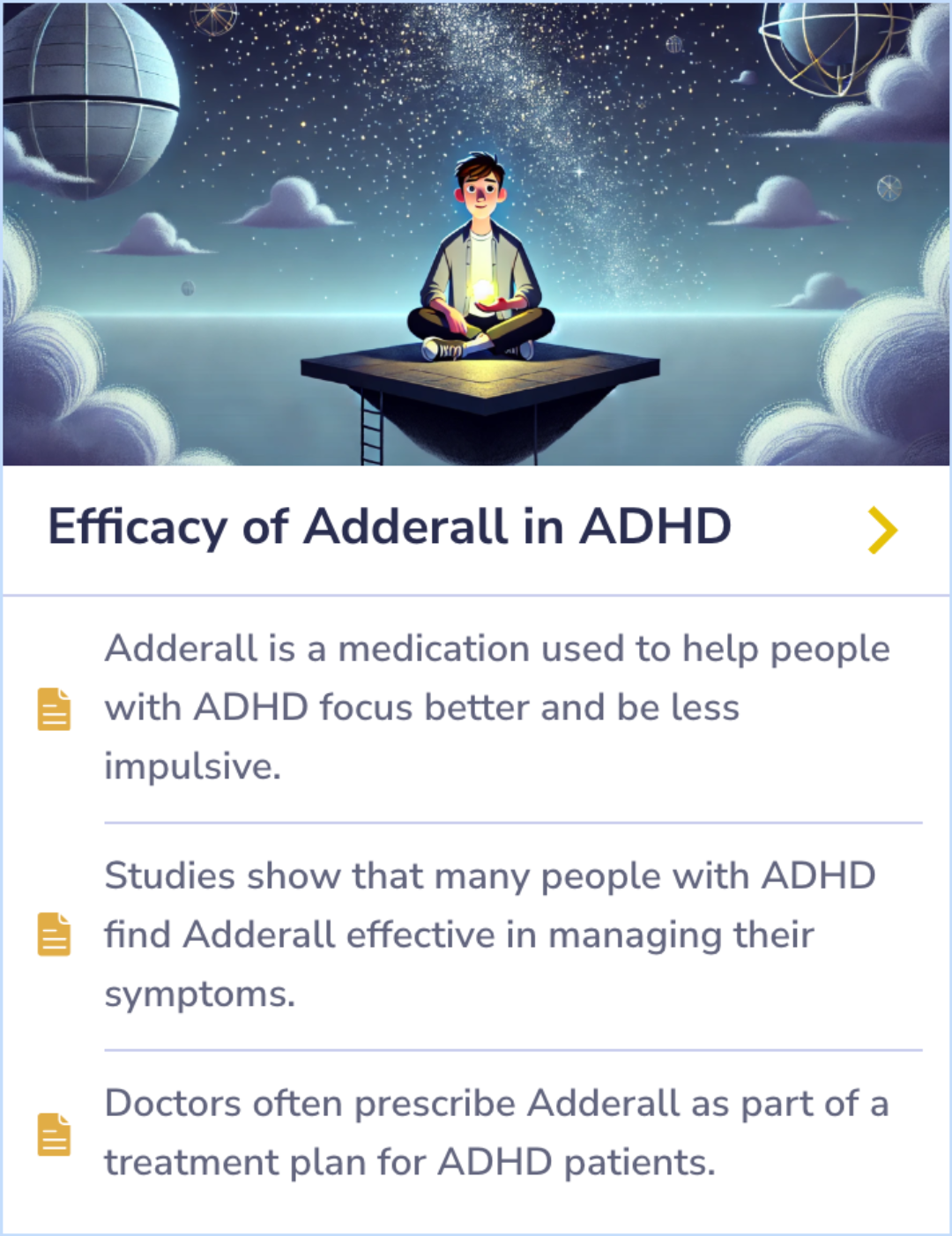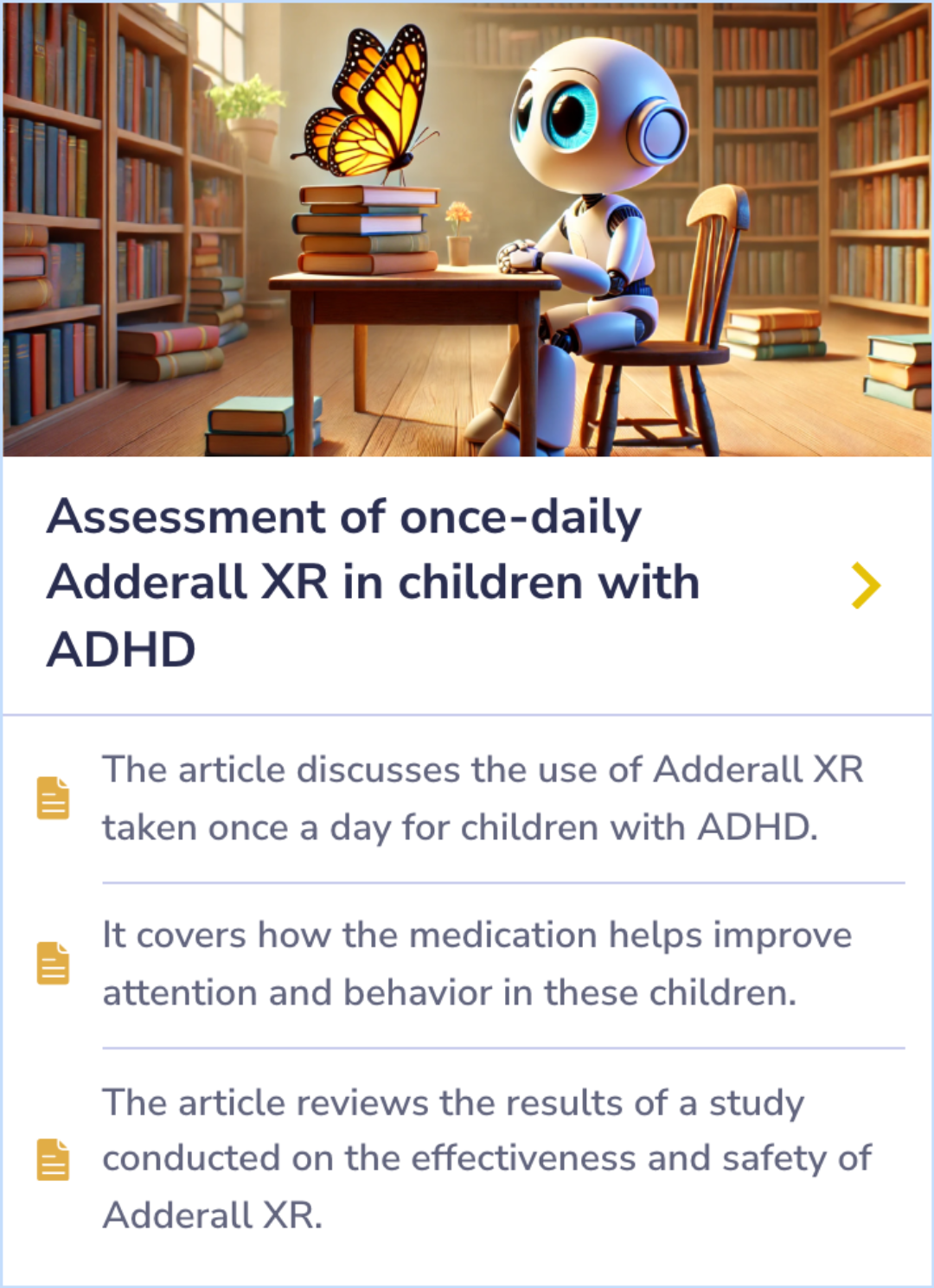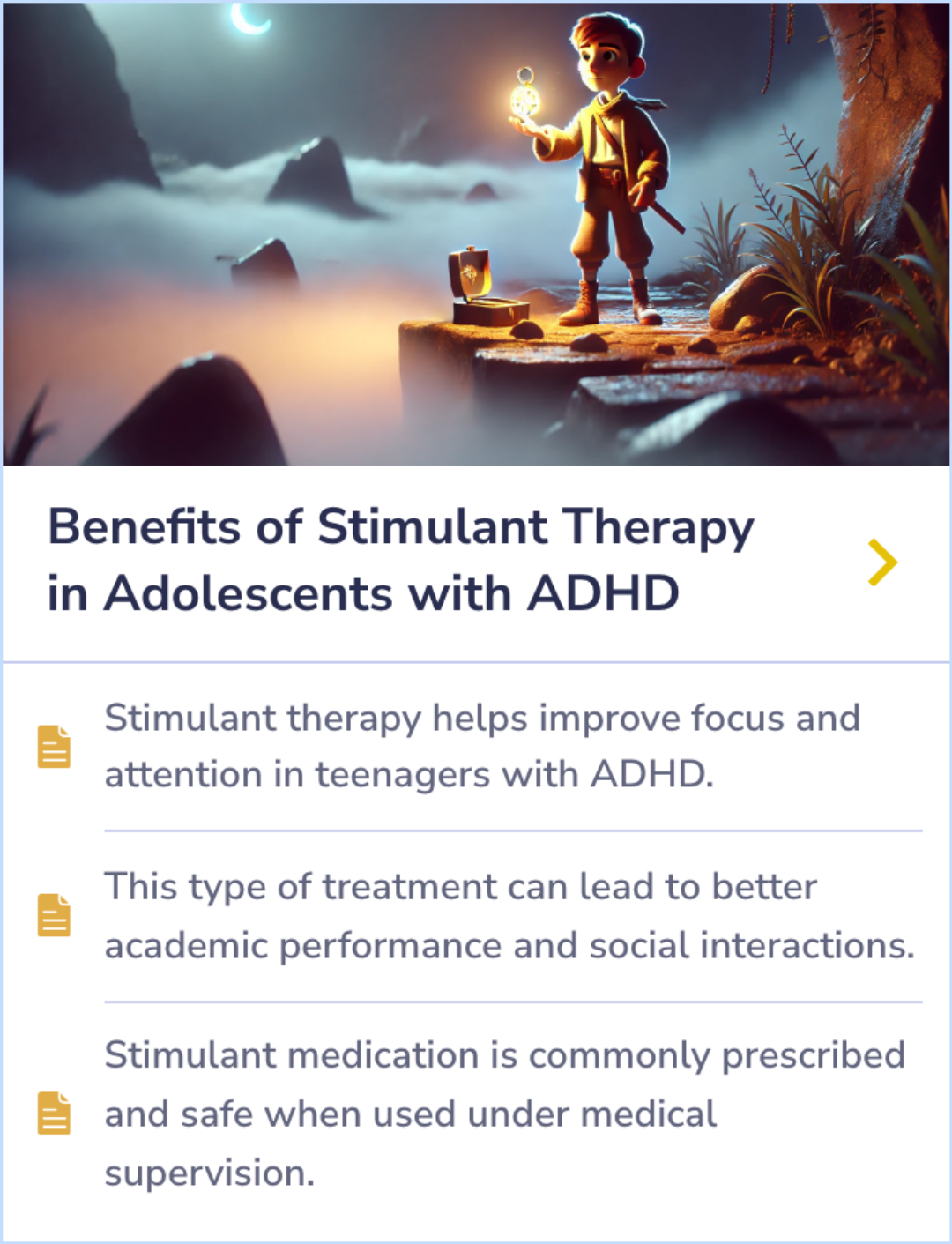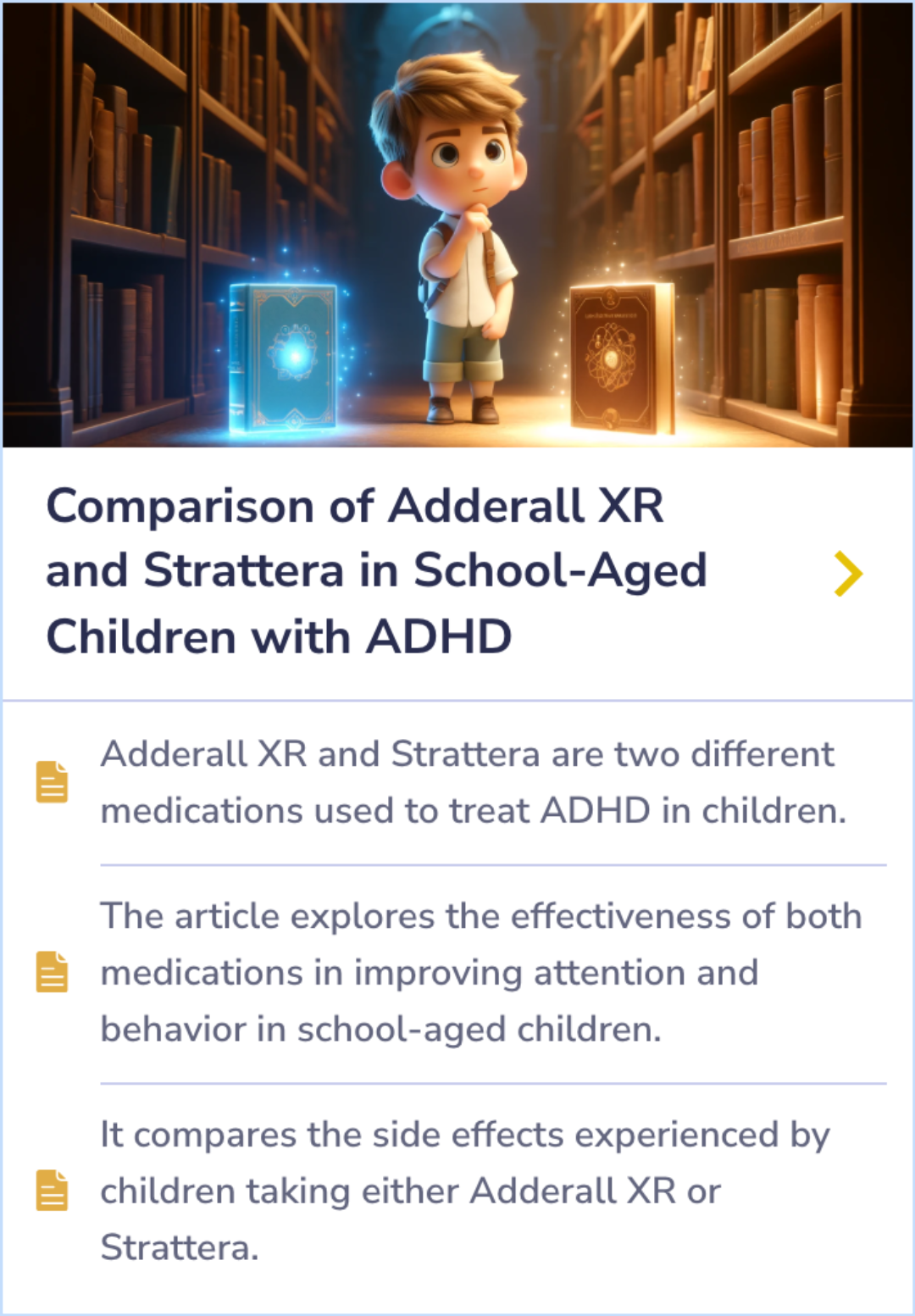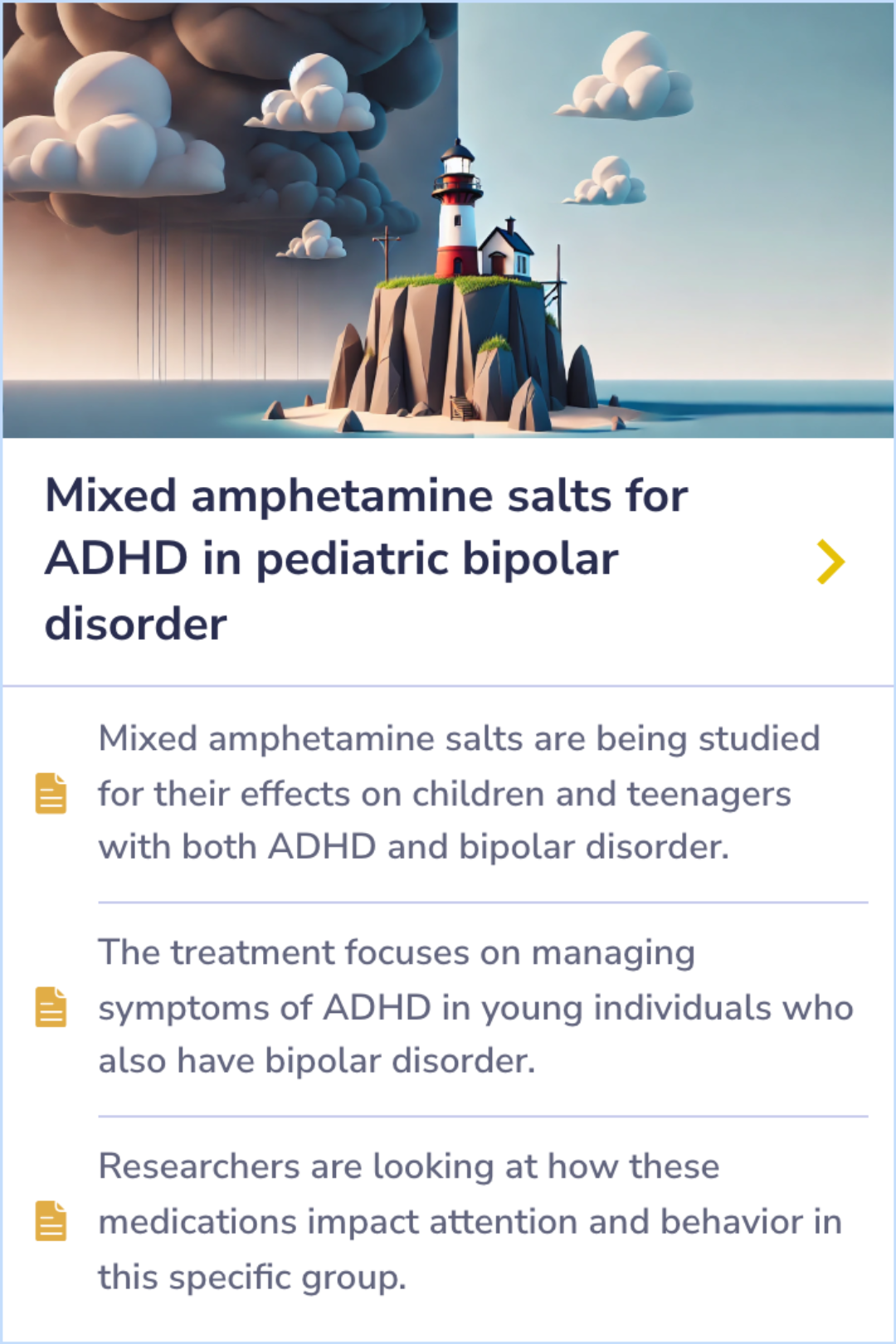Adderall Study Database
Visual Abstract
Placebo-controlled evaluation of amphetamine mixture-dextroamphetamine salts and amphetamine salts (Adderall): efficacy rate and side effects
Efficacy and Side Effects of Adderall in ADHD
October 18, 2024
author
Ahmann PA, Theye FW, Berg R, Linquist AJ, Van Erem AJ, Campbell LR
journal
Pediatrics
Date Published
2001 Jan
Why link to a visual abstract?
What is a visual abstract?
Original
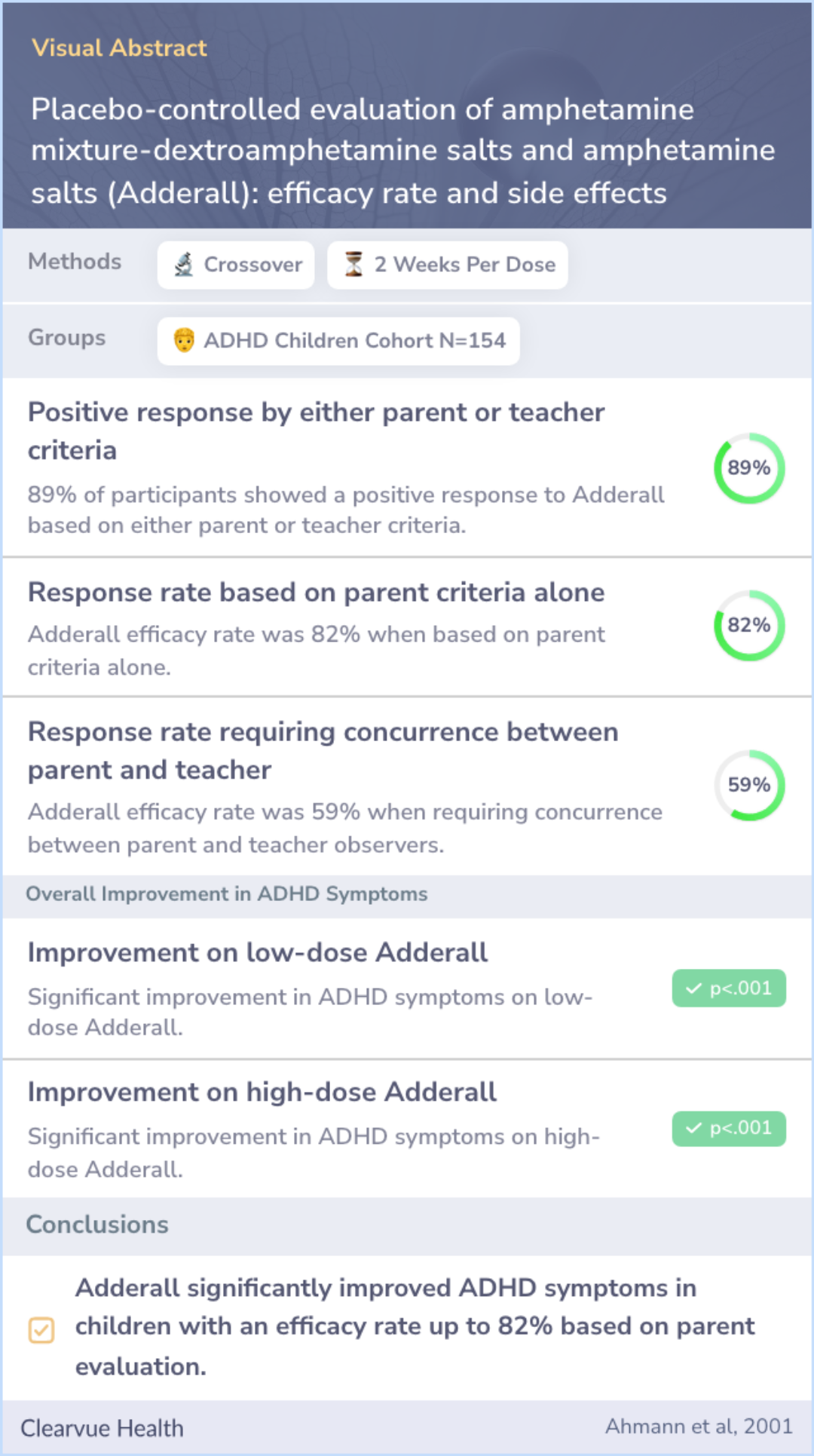
Study Summary
🔬
What They Studied
The study examined the efficacy rate of Adderall (amphetamine salts) in children newly diagnosed with ADHD, alongside the severity of side effects.
💡
What They Found
The study found that Adderall has a high efficacy rate in children with ADHD, with response rates reaching up to 82% based on parent criteria alone.
📚
What This Means
These findings highlight that Adderall is highly effective in treating ADHD in children, with a side effect profile that aligns with existing evidence on psychostimulants. According to current evidence, Adderall is a well-established option for managing ADHD symptoms by increasing attention and reducing impulsivity.
Study Summary
Study Overview
This study examined the efficacy of Adderall in treating children with ADHD. Adderall works by increasing specific brain chemicals related to attention. The study required improvement in a child's behavior both at home and at school to confirm effectiveness. Adderall showed similar success rates compared to other ADHD medications. It had a side effect profile that included decreased appetite and sleep disturbances but also reduced certain negative behaviors. The findings suggest that Adderall might be a preferred option for managing ADHD due to its longer duration of action. Overall, these insights align with the recent guidelines regarding ADHD treatment and the importance of evaluating multiple settings.
Abstract: background
The primary objective of this study was to determine the efficacy rate of Adderall in children newly diagnosed with attention-deficit/hyperactivity disorder (ADHD). A secondary objective was to address the severity of side effects associated with Add...more

Study's Response Criteria
"The strict response criteria used in this investigation to define response to Adderall required that a child's behavioral improvement be documented in 2 environments--the classroom setting as well as the home."
ADHD as a Pervasive Disorder
"Our use of the stringent criteria requiring behavior improvements in both school and home environments was based on the fact that ADHD is a pervasive disorder affecting multiple domains of functioning, and DSM-IV criteria require that symptoms be present in at least 2 of 3 contexts."
Implications of Guidelines
"The recent practice guidelines of the American Academy of Pediatrics strongly suggest that data from 2 environments be included in making treatment decisions."
Study Summary
Methods
The researchers employed a rigorous method known as a randomized, double-blind, placebo-controlled crossover trial. Children between the ages of 5 and 18, who were referred for difficulties with academics or focus, were recruited. A total of 154 participants met the necessary diagnostic criteria for ADHD.
The children were given two different doses of Adderall, calculated per body weight, and a placebo. Each child received each treatment type twice daily over the course of seven days, in separate 2-week trials, allowing the researchers to compare the effects consistently across participants while minimizing bias.
The children were given two different doses of Adderall, calculated per body weight, and a placebo. Each child received each treatment type twice daily over the course of seven days, in separate 2-week trials, allowing the researchers to compare the effects consistently across participants while minimizing bias.
Abstract: methods
Randomized, double-blind, placebo-controlled crossover trial. Participants were prospectively recruited from children 5 to 18 years of age referred for academic and/or attention problems; 154 children who met the Diagnostic and Statistical Manual of ...more

Study Summary
Results
The study showed that Adderall was more effective than a placebo, based on various measures of children's behavior provided by both parents and teachers. The response rate to Adderall varied; 59% when agreement between both parents and teachers was needed, and 82% when relying solely on parent observations. Overall, 89% of the participants demonstrated improvement by either parent's or teacher's criteria.
Regarding side effects, parents reported worsened side effects like decreased appetite, stomachaches, and sleep disturbances while on Adderall, especially with higher doses. Interestingly, some side effects like sadness or daydreaming were reported more during placebo treatments, suggesting these might not be directly linked to Adderall.
Regarding side effects, parents reported worsened side effects like decreased appetite, stomachaches, and sleep disturbances while on Adderall, especially with higher doses. Interestingly, some side effects like sadness or daydreaming were reported more during placebo treatments, suggesting these might not be directly linked to Adderall.
Abstract: results
Efficacy rates were determined by comparing Adderall with placebo during the low-dose crossover sequence and also during the high-dose crossover sequence. The criteria that defined a positive response to Adderall relative to placebo (with each patien...more
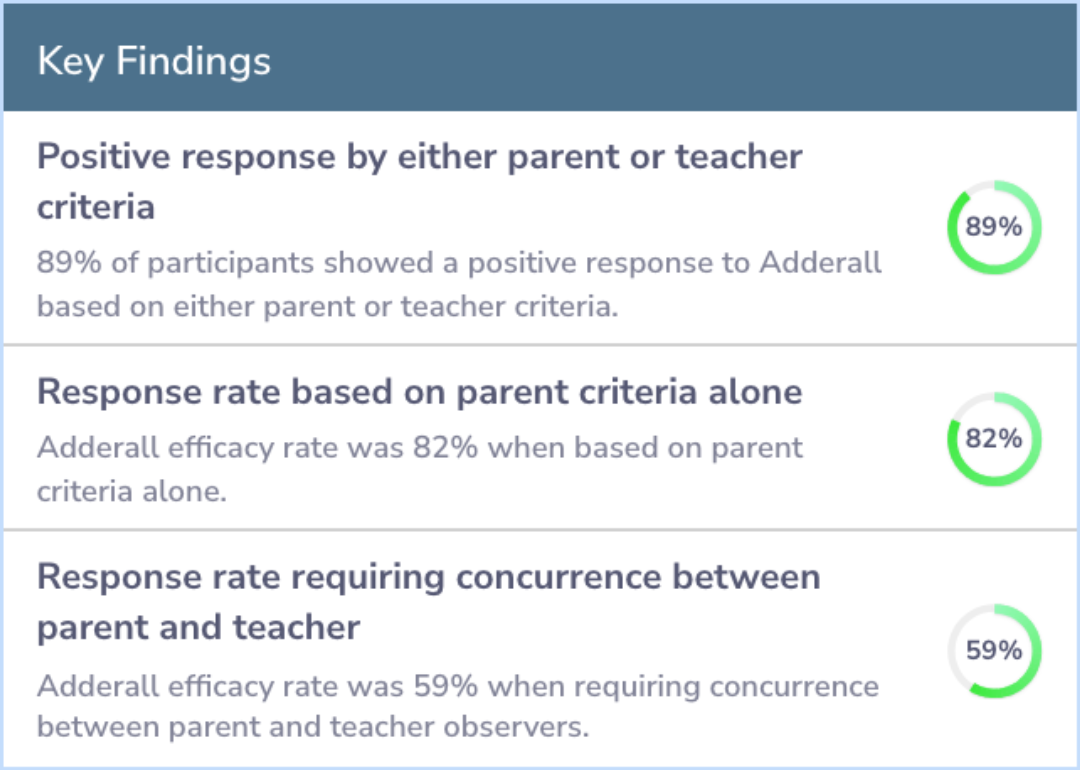
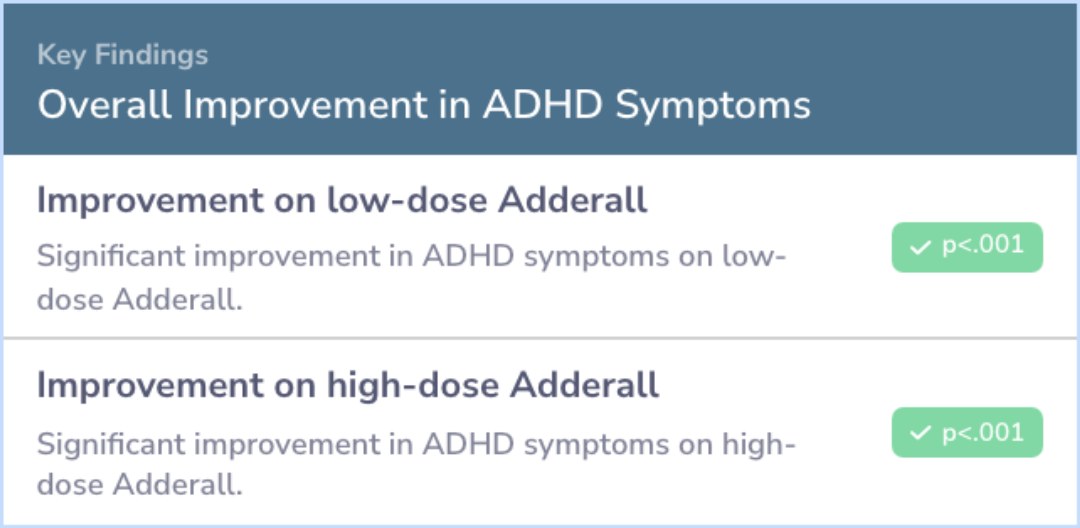
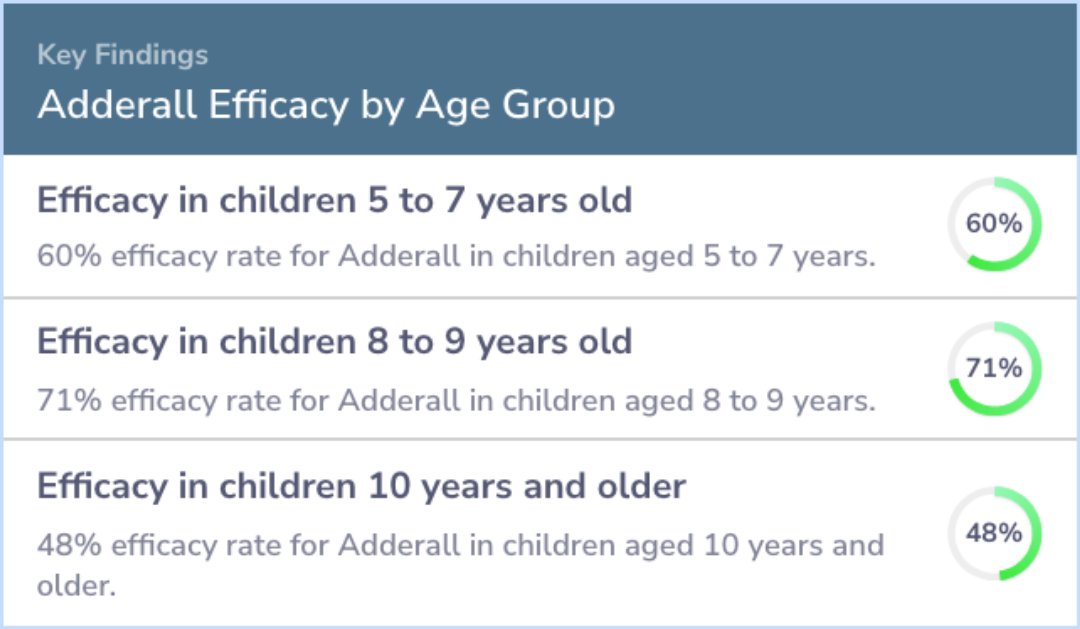
Study Summary
Conclusions
The findings indicate that Adderall is notably effective for children diagnosed with ADHD, demonstrating significant improvements in behavior. The treatment is generally well-tolerated, with a side effect profile similar to other medications used for ADHD.
The study supports the use of Adderall as a reliable option for managing ADHD symptoms in youth, while also indicating that its side effects are manageable and consistent with those expected from similar ADHD treatments.
The study supports the use of Adderall as a reliable option for managing ADHD symptoms in youth, while also indicating that its side effects are manageable and consistent with those expected from similar ADHD treatments.
Abstract: conclusions
We found that Adderall is highly efficacious in our population of youth diagnosed with ADHD. In addition, Adderall is well-tolerated with a side effect profile similar to that reported for other psychostimulants.
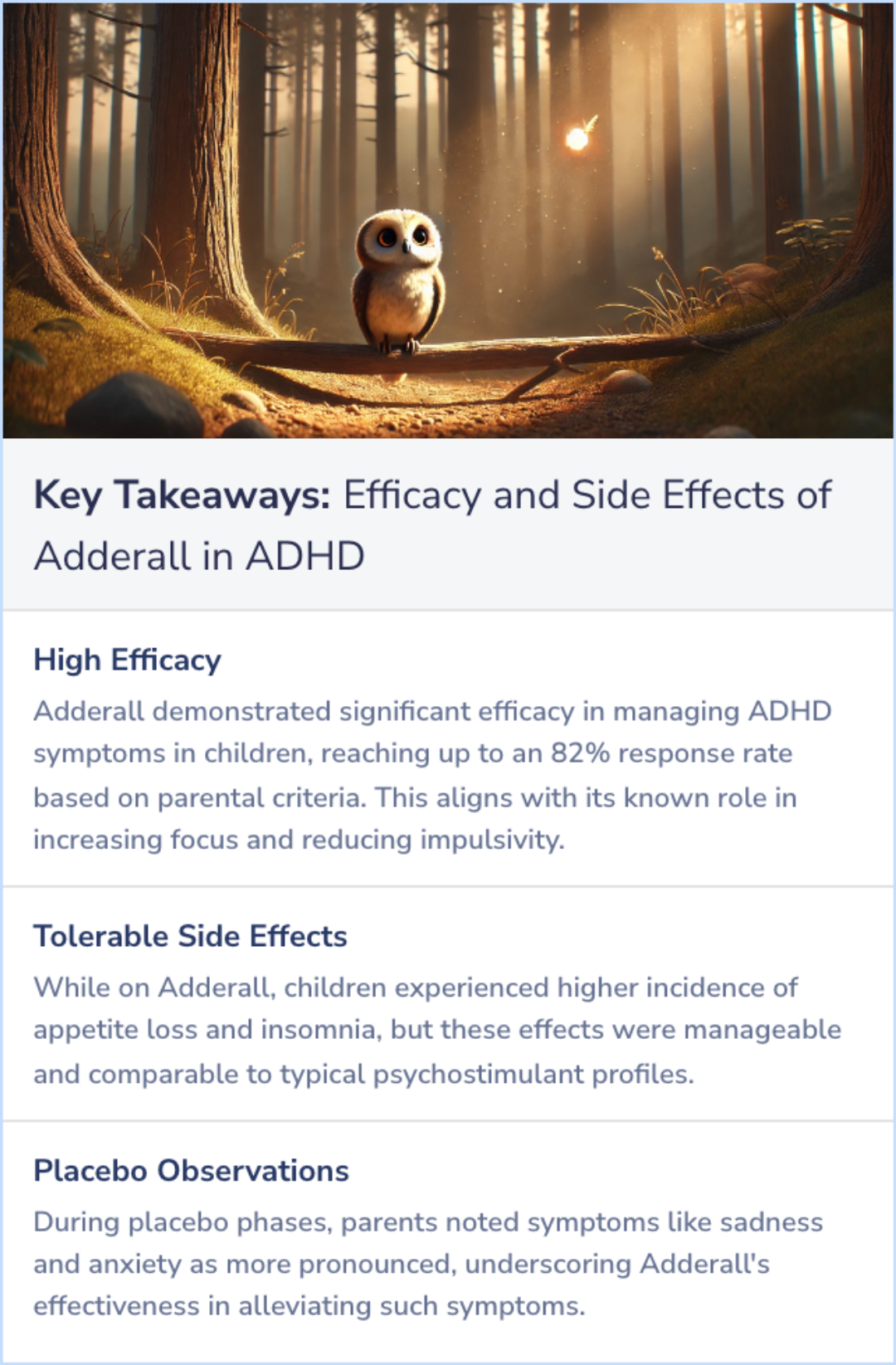
Background Information
Patient Guide
💊
ADHD Treatment Approval
Adderall is FDA-approved for treating ADHD, aiding attention and reducing impulsivity.
🧬
Mechanism of Action
Adderall boosts dopamine and norepinephrine by blocking reuptake, enhancing concentration.
📦
Dosing and Administration
Adderall comes as immediate or extended-release, taken in the morning to prevent insomnia.
📉
Potential Side Effects
Growth suppression and cardiovascular risks are associated with Adderall use in children.
📏
Monitoring Recommendations
Regular cardiac evaluations and growth monitoring are essential for pediatric Adderall users.
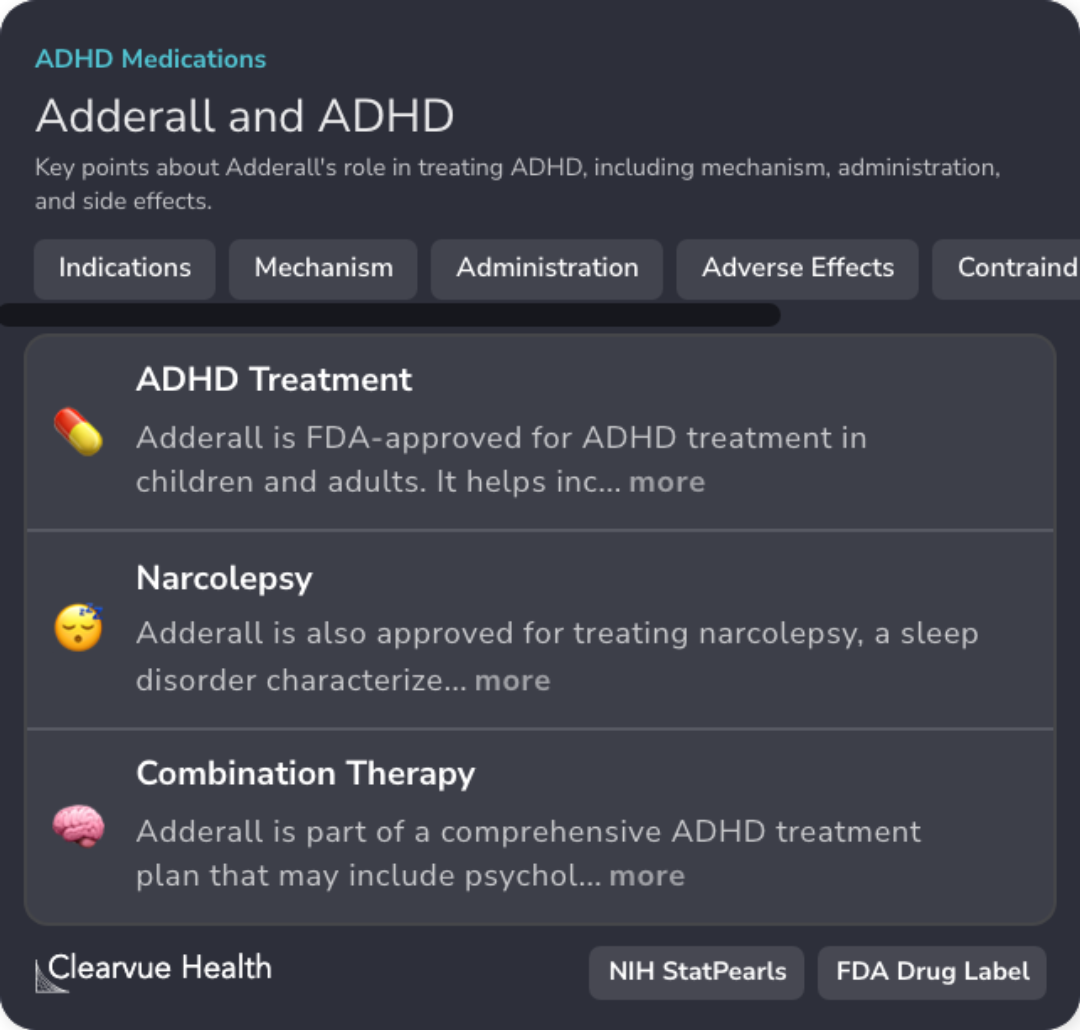
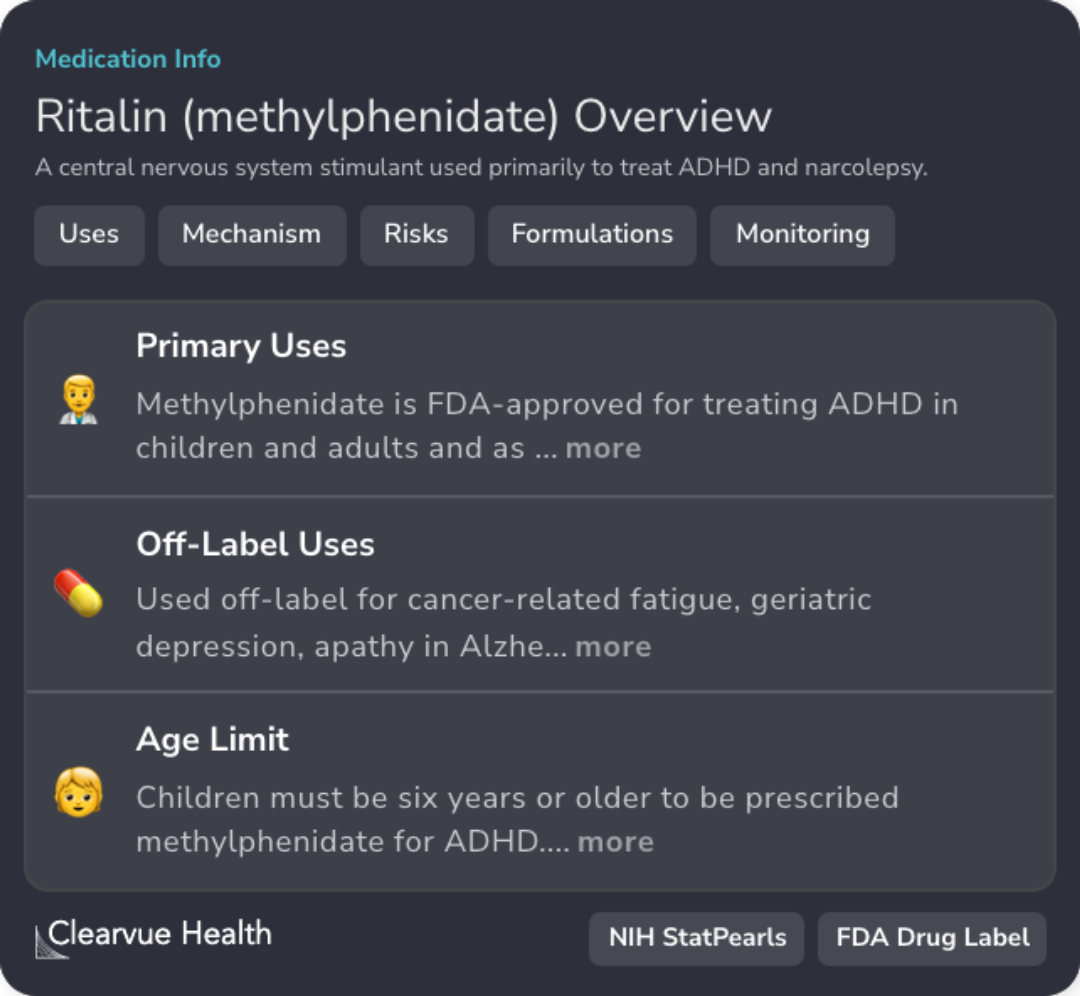
Professional Guide
Expert Opinion: Efficacy and Side Effects of Adderall in ADHD
In line with the study's focus on the efficacy and side effects of Adderall in children with ADHD, clinical guidelines emphasize the need for cardiac assessment prior to starting stimulant therapy in patients with known cardiac abnormalities.
This includes children with exertional chest pain or a family history of cardiomyopathy, aligning with the study's concern about cardiovascular symptoms.
Annual cardiac monitoring is also advised for children on such medications, potentially indicating that stimulant therapy requires continuous medical oversight beyond initial assessment.
Additionally, the potential impact of stimulants on growth velocity highlights the importance of monitoring long-term effects in young patients, which shares relevance with the study's observation of symptom management.
The emergence of psychotic symptoms in some children treated with stimulants underscores the necessity for careful patient selection and ongoing evaluation.
Moreover, the chronic nature of ADHD parallels the need for a comprehensive management approach, reflecting the complexity of ADHD treatment as evidenced in the study.
This includes children with exertional chest pain or a family history of cardiomyopathy, aligning with the study's concern about cardiovascular symptoms.
Annual cardiac monitoring is also advised for children on such medications, potentially indicating that stimulant therapy requires continuous medical oversight beyond initial assessment.
Additionally, the potential impact of stimulants on growth velocity highlights the importance of monitoring long-term effects in young patients, which shares relevance with the study's observation of symptom management.
The emergence of psychotic symptoms in some children treated with stimulants underscores the necessity for careful patient selection and ongoing evaluation.
Moreover, the chronic nature of ADHD parallels the need for a comprehensive management approach, reflecting the complexity of ADHD treatment as evidenced in the study.
Evidence Summary
Adderall in ADHD Treatment Strategies
Adderall plays a key role in ADHD treatment plans by enhancing focus and reducing impulsivity in many patients. As a frequently prescribed medication, it shows effectiveness for numerous individuals, making it a popular choice for doctors when treating ADHD. Many find that Adderall successfully manages their symptoms, which is why it's often included in comprehensive ADHD care strategies.
Evidence Summary
Improving Attention and Behavior in ADHD with Adderall XR
Adderall XR, administered once daily, significantly enhances attention and behavior in children with ADHD. It emphasizes the benefits observed in daily life, alongside a study that confirms its effectiveness and safe use for managing ADHD symptoms in the young. It highlights improvements observed in attention and behavioral aspects, reinforcing its role as a helpful treatment.
Evidence Summary
Boosting Focus and Social Skills with Stimulants
Stimulant therapy plays a key role in boosting focus and attention for teenagers with ADHD, often leading to better grades and enhanced social skills. It remains a popular choice, used under a doctor's guidance to ensure both its safety and effectiveness.
As discussed, while attention to side effects is crucial, the primary focus here is on stimulants' role in improving adolescents' academic and social outcomes.
As discussed, while attention to side effects is crucial, the primary focus here is on stimulants' role in improving adolescents' academic and social outcomes.
Evidence Summary
ADHD Medications: Adderall XR vs. Strattera
Adderall XR and Strattera target the same goal: improving attention and behavior in children with ADHD. How effective are these medications, and what unique side effects do children experience?
This exploration into two different treatments weighs the outcomes and challenges of each. Though both medications aim to enhance focus and conduct, their side effects and impacts vary, presenting different experiences for school-aged children taking them.
This exploration into two different treatments weighs the outcomes and challenges of each. Though both medications aim to enhance focus and conduct, their side effects and impacts vary, presenting different experiences for school-aged children taking them.
Evidence Summary
Exploring Mixed Amphetamine Salts for ADHD and Bipolar in Youth
Mixed amphetamine salts are under the microscope for young people grappling with both ADHD and bipolar disorder. The focus is on how these medications help with attention and behavior issues in this unique group of children and teens.
Researchers are studying how these treatments specifically address ADHD symptoms in young people also dealing with bipolar disorder, potentially offering insights into their dual concerns.
Researchers are studying how these treatments specifically address ADHD symptoms in young people also dealing with bipolar disorder, potentially offering insights into their dual concerns.

